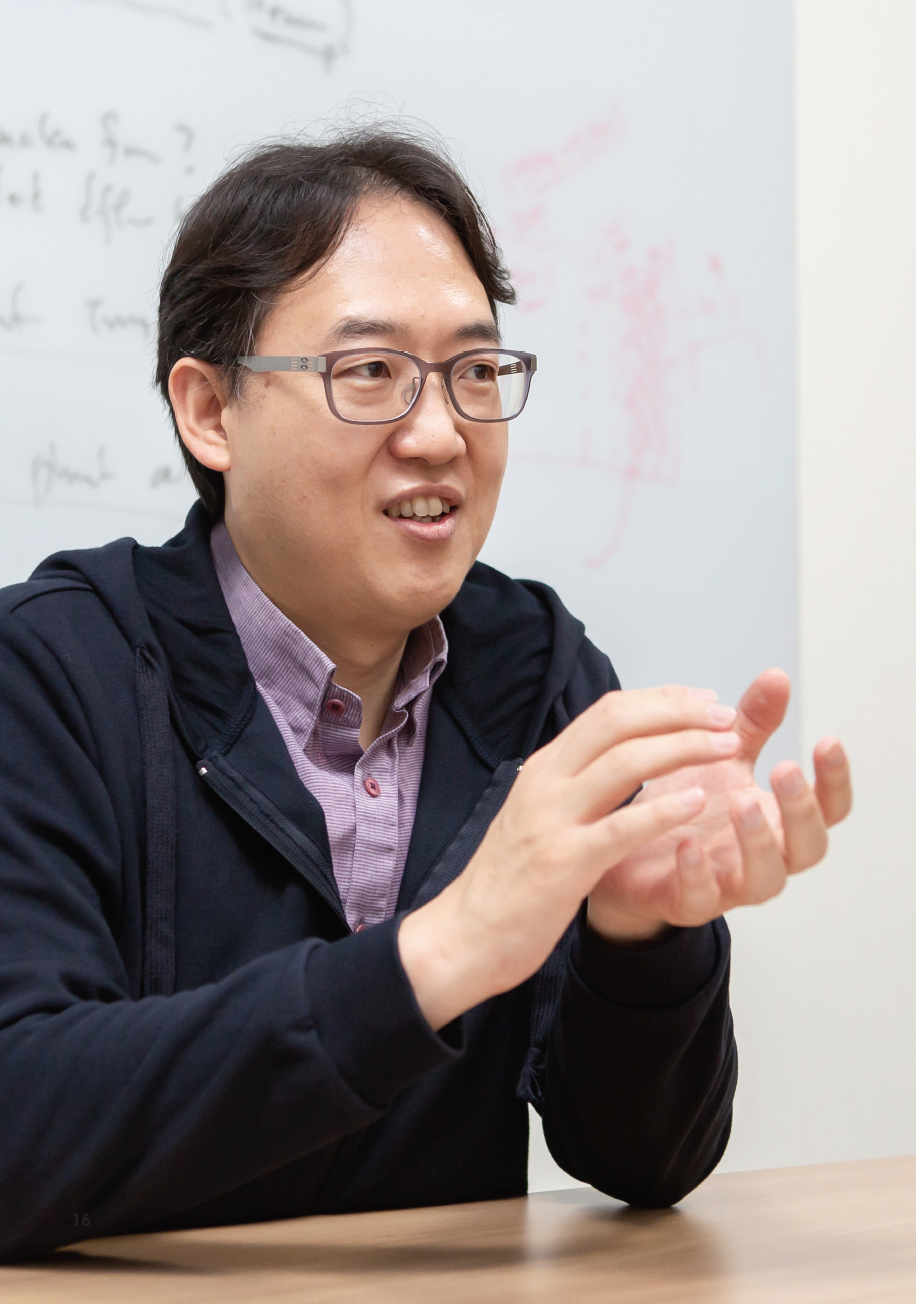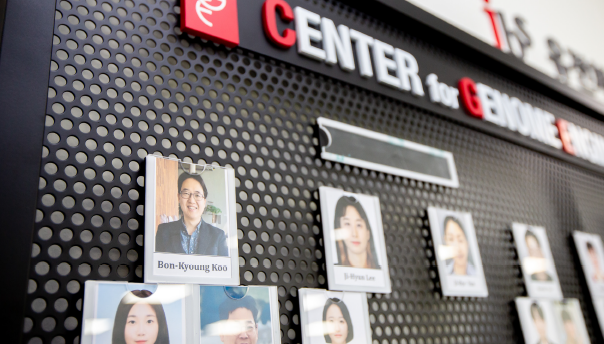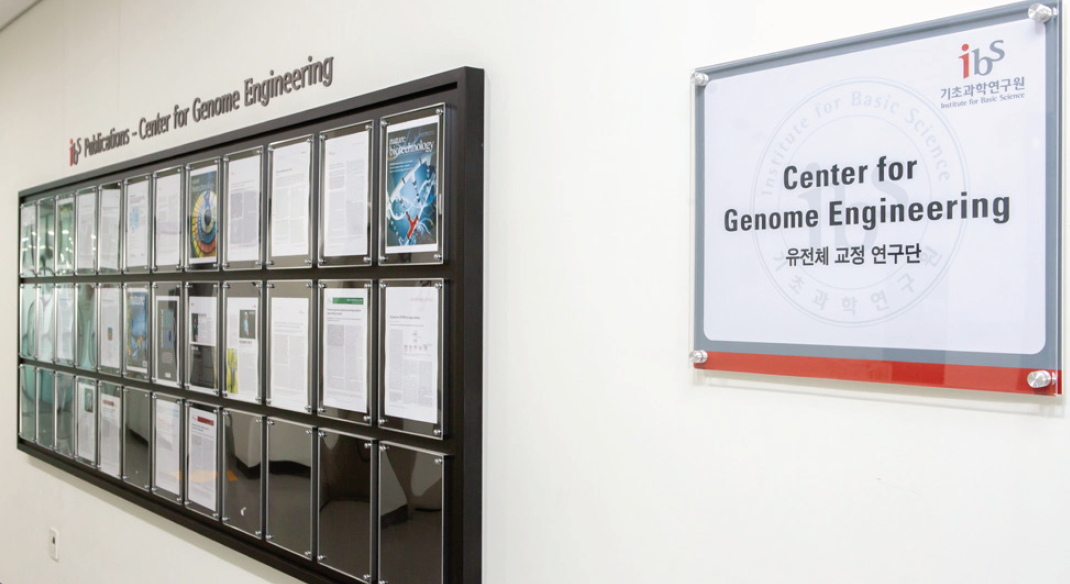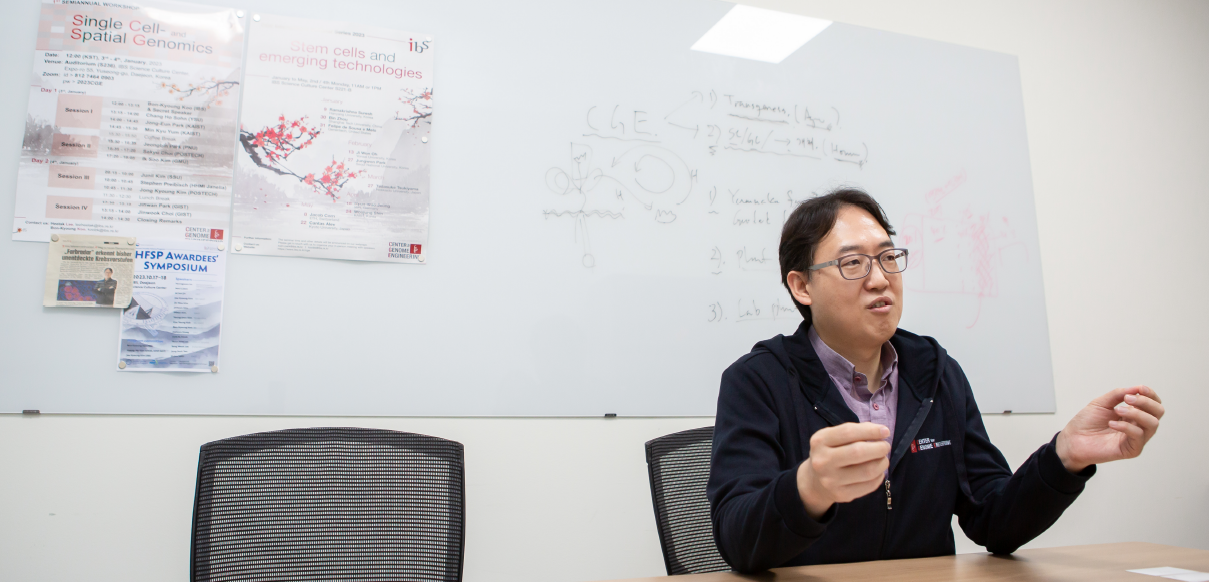
Institute for Basic Science (IBS) officially announced the appointment of former associate director KOO Bon-Kyoung as the new director of the Center for Genome Engineering on August 31, 2023. Director Koo assumed the role of acting director following the resignation of former director KIM Jinsoo in 2021. On July 26th, we interviewed Director Koo to listen to his future plans.
Director Koo's first impression was refreshing. He welcomed us wearing a black zip-up hoodie adorned with the Center for Genome Engineering's logo. His casual clothing almost made him appear like a junior researcher here to guide us to the director’s office. When asked about his choice of attire, he remarked, "I believe this represents our research group the best." This hinted at the direction he intends to take the research group.
Assuming an IBS Center’s leadership at the young age of 45
The Center for Genome Engineering has achieved worldwide recognition in the field of genomic correction since its establishment in 2014. Genomic correction technologies, including gene editing tools such as the 1st generation Zinc Finger Nucleases (ZFNs), the 2nd generation Transcription Activator-Like Effector Nucleases (TALENs), and currently the 3rd generation CRISPR, have evolved under its banner. The departure of former Director Kim, a global authority in the gene editing field, left a significant vacancy, and Director Koo stepped up as a candidate from within the group. Koo briefly served as an acting director before being officially appointed.
Director Koo is not your typical scientist in South Korea who usually goes through an elite education track. He refers to himself as a “non-science high school,” “non-Seoul National University,” “non-academic,” and “non-American” background. After completing his master's and doctoral degrees at POSTECH, he worked as a postdoctoral researcher at the Hubrecht Institute in the Netherlands. Following that, he led independent research as a group leader at the Cambridge Stem Cell Institute in the United Kingdom and the Institute of Molecular Biotechnology in Austria.
Even though he has an atypical background, his research achievements are far from being lackluster. He received the MBC Award for Mystery of Life (2018), a commendation from the Ministry of Science and ICT in 2021, and in 2022, he was recognized as one of the most “Highly Cited Researchers” by Clarivate. Notably, he is relatively younger compared to most of the 63 scientists selected in South Korea.
“While serving as acting director, I had many conversations with the scientists in the Center. There was a need to reassure them because they were anxious about whether the research Center could continue its operation,” Director Koo said.
Maintaining the existing research Center under a different leader is a significant challenge. First and foremost, finding a scientist capable of leading the current Center itself presents a daunting task. IBS appoints the most outstanding scientists in the field as directors when establishing new research Centers. However, in the case of appointing a new director to an existing Center, there is hardly enough time to reorganize the Center according to the roadmap of the new director. While a newly established Center is evaluated five years after its inception, the existing Center must undergo evaluation three years after the new director's appointment. Due to these difficulties, many previous attempts to appoint new directors for Centers with vacant positions have failed. Director Koo confidently stated, “Even though the leader has changed, the Center for Genome Engineering is still recognized as the top research group in the world.”

"Even though the leader has changed, the Center for Genome Engineering is still recognized as the top research group in the world."
Sharpened Scissors Are Ready for Use
Director KOO Bon-Kyoung is an expert in genetic engineering. However, concerns were raised about whether he was suitable as the head of the Center for “Genome Engineering”. Director Koo addressed these concerns by giving an example involving the actual "scissors."
Gene editing technology has become increasingly sophisticated over the years. The third-generation CRISPR is capable of precisely cutting desired sequences of DNA, which makes it an excellent tool for complementing the first and second-generation scissors. CRISPR technology uses a guide RNA and the Cas9 protein (a cutting enzyme), which makes them a highly effective tool for editing nuclear DNA.
However, currently, it's not possible to deliver the guide RNA to other organelles besides the nucleus. This means that using CRISPR is not possible for mitochondrial DNA editing. The researchers found solutions in the first and second-generation scissors, which were previously considered increasingly obsolete with the introduction of CRISPR. The Center for Genome Engineering has never given up on and continuously improved these older toolkits, making them even more precise and effective.
“Currently, gene editing technology has reached a very advanced level, and it will continue to advance further. It's also important to explore how far we can use these advanced scissors. While preparing for the second phase of our Center, we discussed its future direction. We concluded that we should explore how to improve these scissors further and find out where and how to use them.”
The first direction involves the potential use of artificial intelligence (AI). Following the success of DeepMind's AlphaGo, AI has made its way into the field of biology. In 2018, DeepMind unveiled “AlphaFold1,” an AI that analyzes protein structures, during the Critical Assessment of Structure Prediction (CASP) competition. In 2020, AlphaFold2 within 30 minutes managed to analyze bacterial protein structures that scientists had failed to determine for years. In 2022, BAIK Min-kyung, a former postdoctoral researcher at Washington University (now a professor at Seoul National University's Department of Life Sciences), developed RosettaFold, an AI that surpassed the performance of AlphaFold2. RosettaFold was recognized as the “Most Innovative Research Achievement of 2021” by the prestigious scientific journal Science in December 2021.
Director Koo believes that AI can also be applied to gene editing. He expects that AI will not be limited to just analyzing protein structures, and they will be able to design proteins used as cutting enzymes in a context-dependent manner.
“In the Stone Age, people selected good stones to make tools. It was only during the Bronze Age that they began to create the shapes they wanted using casting. Biology is currently transitioning from the Stone Age to the Bronze Age. We're entering an era where we can design proteins as we please.”

The second direction is finding ways to use these tools in various organisms. To apply gene editing, customized methods need to be developed depending on the organism in question. Even if you're cutting the same gene, different techniques are required when dealing with a mouse versus a monkey. That's why gene editing researchers worldwide are working on developing customized gene editing methods tailored to their respective fields. Research in the livestock and agriculture industries is particularly active.
“IBS is a research institute that seeks to explore ‘Big Questions,’ the fundamental curiosity of humans that underlies all research. We chose the goal of developing customized editing methods for a variety of species with this in mind.”
The research group’s first target is the clownfish (Amphiprion percula), which is a well-known animal from the animated movie “Finding Nemo.” The ability of this organism to swap gender posed another intellectually intriguing challenge to the researchers for applying gene scissors. Moreover, clownfish share a common ancestor with popularly eaten fish like sea bream and sea bass. Developing gene editing techniques for clownfish could lead to practical applications in breeding these valuable species. Additionally, discussions are underway for a collaborative effort with Seoul National University and the Korea Research Institute of Bioscience and Biotechnology to build the technology for applying various kinds of gene scissors to monkeys.
Lastly, the research group will also focus on studying the use of genetic scissors in various types of cells. Until now, gene editing technology has been honed to manipulate animal genes in various ways. The goal is to expand this capability for practical applications. Past research mainly created animal models by introducing editing the genes within fertilized eggs. This method works well for animals like mice, which produce many eggs. However, it's challenging to use this method for animals that produce fewer eggs. One solution for utilizing these animals is by applying the genetic scissors to sperm or somatic stem cells.
“In the future, the outputs of the Center for Genome Engineering can become the foundation of all research. For example, due to the knowledge that a significant number of zoonotic viruses originate from bats, there's a growing need to study bats. If we want to study bat genes, it is necessary to develop a method to manipulate them. We aim to explore the fundamental technologies that can shape the themes of future research in many areas of life science.”

Creating a research center where junior researchers can thrive
To achieve these goals, the research group will need to work with exceptional scientists. Director KOO Bon-Kyoung expressed his ambition to lead the research group based on his past experiences as a “non-mainstream” scientist.
“After working as a postdoctoral researcher for about ten years at Seoul National University and in the Netherlands, I was able to establish my own research laboratory. Until then, I had written first-author papers as a part of someone else’s lab, but now, I will be able to conduct my own research as a corresponding author. If we have a good system for nurturing the next generation of researchers, I believe it is possible to produce researchers suitable for leadership positions in about ten years. In fact, colleagues I worked with in Europe have become group leaders at renowned research institutions like the Max Planck Institute. I want to apply this nurturing system I learned in Europe to my group at the IBS.”
Director KOO Bon-Kyoung didn't initially plan to return to Korea, since he wanted to continue his research in a more research-friendly environment abroad. However, he was moved by requests from fellow researchers in Korea, who asked for his assistance in mentoring young scientists.
“You know how there is a Death Valley for startups? They have fantastic ideas and products, and if they can endure, they have the potential to succeed. However, they often lack the funds to sustain themselves through the initial phase. It's the same for young leaders who are trying to establish their own research laboratories. If they can't endure the early stages, they'll quickly fall behind. Once you fall behind, catching up is challenging.”
Groups at the forefront of research are continuously achieving new results, competing with each other, and advancing their fields day by day. After competing with these groups, Koo returned to Korea with a lofty goal. However, he would risk falling behind if there are delays in adjusting to the new Center. Director Koo stated, “Let’s say that in overseas, a particular research is done using primates. However since Korea lacks primate research facilities, researchers here say they will work using mice instead. This is not going to produce the necessary results.” He reaffirmed his goal to turn the Center into a location that can provide opportunities for the next generation of scientists.
He also plans to take the lead in internationalizing the research center. To achieve this, he aims to invite and nurture exceptional student researchers from various countries.
"The Austrian Institute of Molecular Biotechnology may not be a place that can attract top-notch researchers solely by its name, like Harvard, MIT, or Yale. Instead, they have been identifying outstanding students from an early stage. They keep making proposals like, ‘Our institution's doctoral program is excellent. Would you like to give it a try?’ They also actively attempt recruit excellent professors. After 20 years of such efforts, it is possible to grow into an internationalized and outstanding research center."
To implement this plan, it is necessary to start recruiting foreign intern students. In 2022, the Center recruited four students, and those from India and the Netherlands are particularly outstanding. These students even expressed interest in pursuing their doctoral studies at the Korea Advanced Institute of Science and Technology (KAIST). Director Koo stated, “If they pursue their doctorate as well, they will continue their research while living in Korea.” He explained that the Center plans to actively utilize postdoctoral researchers and graduate student interns in the future. In the long run, Koo also expressed the desire to produce research leaders at the level of research center directors.
“I'm planning to give opportunities to about ten young scientists. It would be great if all ten succeed, but even if three of them reach a level similar to myself in ten years, I would call that a success.”


 캡처.JPG
캡처.JPG















